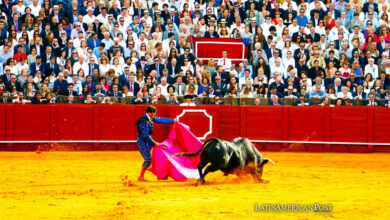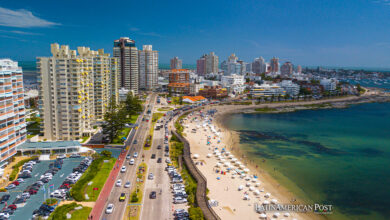Vibrant Memories: Understanding the Day of the Dead’s Deep Significance
As the marigold petals scatter and sugar skulls gleam under the moonlit November skies, Día de los Muertos, or the Day of the Dead, blossoms not just in Mexico but around the globe. This celebration, transcending mere remembrance, knits a vibrant tapestry of life, death, and cultural continuity

Photo: 02/11/2023.- People light the graves of their loved ones with candles in the early morning of November 2, in Xochitlan Todos Santos, Puebla state, Mexico. EFE/Hilda Ríos
The Latin American Post Staff
Escucha este artículo
Leer en español: Recuerdos vibrantes: comprender el profundo significado del Día de Muertos
A Timeless Celebration: Día de los Muertos
Once a year, as October wanes and the chill of November beckons, something magical unfolds across Mexico and beyond. Día de los Muertos, known in English as the Day of the Dead, transcends time and geography to become a globally celebrated phenomenon. Rooted in thousands of years of tradition, this festival offers a kaleidoscopic perspective into the human relationship with mortality and memory.
Popularized in movies like "Coco" and the opening of "Spectre," Day of the Dead is marked by iconic symbols like papel picado (delicately chiseled paper banners), Calaveras (decorative skulls), and vivid marigold flowers. Unlike Halloween's ghoulish overtones, the Day of the Dead emanates warmth, respect, and enduring bonds, turning what might seem somber into a colorful affirmation of life.
Bridging the Living and the Dead
Spanning November 1st and 2nd, these days are more than dates on a calendar; they are a spiritual passage. It's believed that during this period, the veil between the living and the dead lifted gently, allowing spirits to mingle with their families again. This poignant concept isn't confined to Mexican borders — its essence echoes in various forms worldwide.
In the Philippines, the first two days of November, known as Undas, mirror similar sentiments. Here, people gather in cemeteries not just to mourn but to celebrate the lives of those who've passed with feasts, songs, and stories. Graves are cleaned and lavishly decorated, reflecting a communal embrace of ancestry and heritage.
Further away in Haiti, Fèt Gede (Festival of the Dead) paints a different yet familiar picture. In an explosion of white, black, and purple, Haitians take to the streets in a vibrant blend of mourning and festivity. Parades snake through the streets, capturing a raw, energetic acknowledgment of death and the ancestral spirits known as the Gede.
Bridges of Connection Across the Metaphysical Divide
What truly sets the Day of the Dead apart is its intrinsic ability to merge sorrow with celebration, creating a holistic ritual that honors death as a natural, integral part of life's tapestry. The creation of altars, or “ofrendas”, is central to this. Laden with the deceased's favorite foods, personal belongings, and photographs, these altars aren't mere memorials. They are bridges of connection, loaded with stories and sentiments, reaching across the metaphysical divide.
The culinary aspect of the celebration is also significant. The traditional pan de muerto (bread of the dead), a sweet roll adorned with bone-shaped pieces, isn't just food; it's a symbolic gesture of nourishment for the souls. Each sugar skull, intricately decorated, bears a name — not to frighten but to personalize and keep alive the memory of the individual it represents.
A Philosophy of Embracing Life through Embracing Death
As globalization knits cultures closer, the Day of the Dead's core themes resonate universally, touching hearts beyond its native Mexican roots. It's a testament to the shared human experience — the understanding that life is transient and should be celebrated, that memories should be cherished, and that death, while inevitable, is also a passage to something beyond our understanding.
Also read: Indigenous Communities in Mexico Struggle Amidst Climate Change Crisis
Continuity in the Face of Life's Eternal Cycle
Yet, the Day of the Dead is more than just a ritual; it's a philosophy. In embracing death, the festival teaches us to fully embrace life — to appreciate the fleeting nature of our existence and to cherish the connections that outlive physical presence. It reminds us that in memory, in the stories we tell and the traditions we uphold, our loved ones continue to influence and guide us, transcending the impermanent nature of life itself.
As the world spins on, often indifferent to individual loss, Día de los Muertos stands out as a poignant counterpoint. It asserts that as long as we remember, celebrate, and tell their stories, those we love never truly leave us. In this unique interplay of death and life, sorrow and joy, memory and hope, the Day of the Dead continues to echo the heartbeat of countless generations — a rhythm of continuity in the face of life's eternal cycle.



